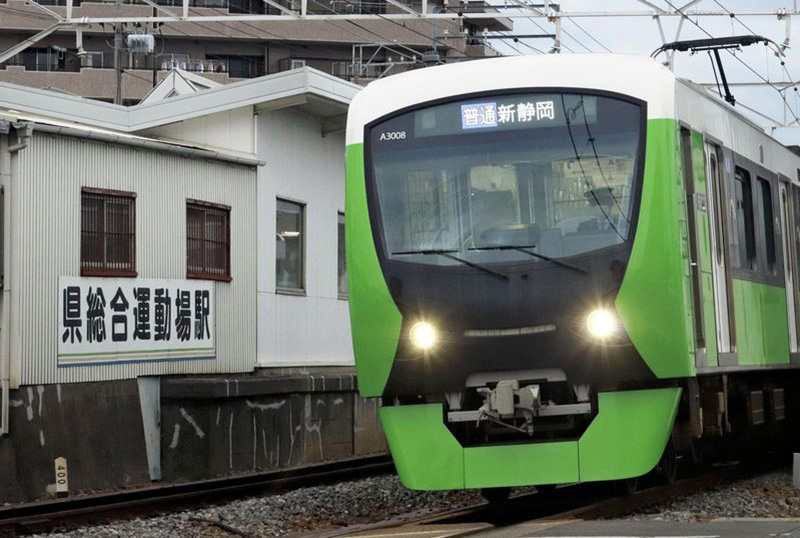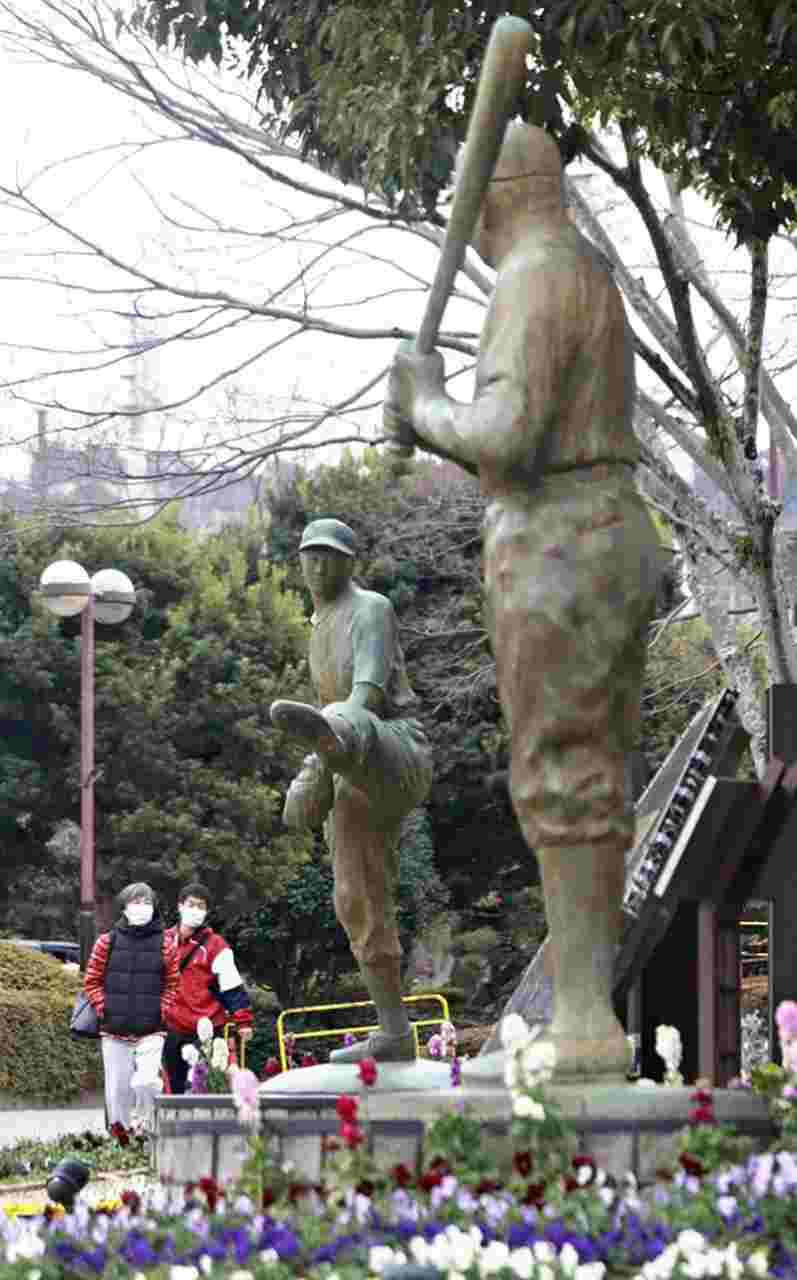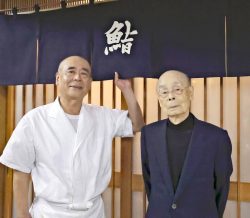
Ken Sogo Undojo Station is used by many baseball fans.
15:12 JST, March 1, 2022
SHIZUOKA — Kusanagi Stadium in Suruga Ward, Shizuoka, is sometimes referred to as a “legendary baseball stadium.”
Two bronze statues in front of the stadium — a five-minute walk from Ken Sogo Undojo Station on Shizuoka Railway Co.’s Shizuoka Shimizu Line — help explain the nickname.
The statues are of legendary Japanese pitcher Eiji Sawamura and Hall of Famer Babe Ruth, known as a “god of baseball.”
Kusanagi Stadium became the stage for a game between Japanese and U.S. all-star teams prior to World War II in which then 17-year-old Sawamura, who later starred for the Yomiuri Giants, put on a stunning performance against a powerful U.S. team featuring Ruth.
The 10th game of the second U.S. all-star tour of Japan was played in Shizuoka on a crisp autumn day on Nov. 20, 1934. The U.S. team had won all nine of the previous games, crushing Japan 21-4 in the ninth game.

Bronze statues of Eiji Sawamura with his leg raised high and Babe Ruth holding a bat
The attention of the 20,000 spectators at Kusanagi was squarely on the great slugger Ruth, who was making his first trip to Japan. However, the game turned out quite differently from their expectations.
Sawamura, the Japan team’s starting pitch, struck out the big-hitting Americans one after another from the first inning. The lone run of the game came on a seventh-inning home run by Lou Gehrig, but it was just one of five hits allowed by Sawamura — certainly a “major league-class” performance. It shocked the U.S. baseball world, which dubbed him “Schoolboy Sawamura.”
Ruth, who had one hit in three at-bats, reportedly said he didn’t think it would be such a close game and had nothing but praise for Sawamura, although there is also the story that the Yankees great said the sun was directly in his eyes when he stepped into the batter’s box.
Train station’s important role
The stadium and its illustrious history have a deep connection with Ken Sogo Undojo Station. Shizuoka Railway built the stadium to attract more train passengers. The railway was founded in 1919 as Sunen Denki, and its initial focus was on the transportation of tea and the development of a railroad connecting the center of Shizuoka City with Shimizu Port.
Development of areas along the line also proceeded, with an amusement park called Kitsunegasaki Yuenchi opening in 1926 complete with a boating pond and a zoo.
In 1930, the predecessor of Kusanagi Stadium called Shizuoka Baseball Stadium was built in its current location to help improve the physical strength of young residents and motivate people to use the station more.
The stadium with infield and outfield stands became known as the best stadium in the Tokai region. The distance to the right and left field is 91 meters, and that to the center field wall is 115 meters. It became one of the most famous landmarks in the prefecture, along with the amusement park. The stadium was affectionately called the “Dentesu kyujo” (electric railway stadium).
The Japan-U.S. baseball series was held four years after the completion of the stadium. Enthusiasm for baseball had been on the rise in the prefecture by that time as Shizuoka Middle School (now Shizuoka Prefectural Shizuoka Senior High School) became the first prefectural team to win the national high school baseball championship at Koshien Stadium in Nishinomiya, Hyogo Prefecture, in the summer of 1926.
It is not difficult to picture that many baseball fans took the train and headed for the stadium.
Hopes for the future
The stadium was donated to the prefecture along with surrounding land in 1939. Although there have been major renovations since then, the legacy of the Japan-U.S. baseball series remains.
Visitors can examine the former location of the home base on which Ruth and other players stood, at the exhibition room inside the stadium. In 1991, the prefecture installed bronze statues of Sawamura and Ruth facing each other.
“The history of the Japan-U.S. baseball games has been passed down from generation to generation. Recently, we were interviewed by a TV company, for instance, about Shohei Otani’s fantastic performances in the major league,” said Susumu Sasase, 71, of Tokyo Dome Sports Co., which manages Kusanagi Stadium.
Professional and high school baseball games are still held at Kusanagi Stadium. There is also a track-and-field stadium nearby.
Most of the passengers use Shizuoka Railway for commuting to work or school, but many people use Ken Sogo Undojo Station, whose name was changed from Undojo Mae in 1990, for special occasions. On days when professional baseball games are held, for example, trains run on a special schedule.
The number of passengers at the station per day was more than 3,500 in fiscal 2017-19, but dropped to 2,723 in fiscal 2020 due to the cancellation of many sporting events amid the COVID-19 pandemic.
“We hope the pandemic will subside soon and the city will be filled with vitality again,” said Taketada Kita, the head of Shizuoka Railway’s railway department.
When many can gather again at stadiums, the home of so much drama, the station is certain to become even livelier.
Related Tags
"Features" POPULAR ARTICLE
-

Sanrio to Open Museum in Yamanashi Pref. Dedicated to Founder, Exhibits Include Hello Kitty, Other Characters
-

Legendary Sushi Chef Jiro Ono Turns 100: ‘I Have No Regrets’
-

Autumn Foliage Surrounds Visitors to Tokyo’s Showa Kinen Park
-

My Daughter No Longer Speaks to Me, But I Want to See Her and My Grandchild
-

Kumamoto: Public Bath Refurbished as Library Where You Can Chat, Take Photos
JN ACCESS RANKING
-

Keidanren Chairman Yoshinobu Tsutsui Visits Kashiwazaki-Kariwa Nuclear Power Plant; Inspects New Emergency Safety System
-

Imports of Rare Earths from China Facing Delays, May Be Caused by Deterioration of Japan-China Relations
-

University of Tokyo Professor Discusses Japanese Economic Security in Interview Ahead of Forum
-

Japan Pulls out of Vietnam Nuclear Project, Complicating Hanoi’s Power Plans
-

Govt Aims to Expand NISA Program Lineup, Abolish Age Restriction
























